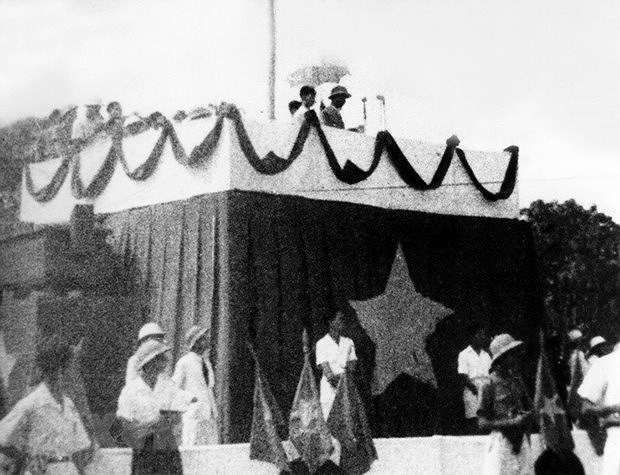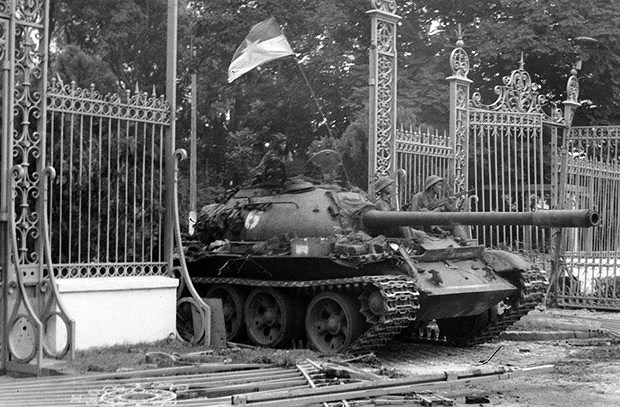The country’s achievements have once again testified to the fact that the Communist Party of Vietnam (CPV) is the only organisation and force leading the revolution and the entire people to obtain glorious successes over the past 90 years.
 President Ho Chi Minh reads the Declaration of Independence at Ba Dinh Square in Hanoi on September 2, 1945, marking the establishment of the Democratic Republic of Vietnam, now the Socialist Republic of Vietnam (File photo: VNA)
President Ho Chi Minh reads the Declaration of Independence at Ba Dinh Square in Hanoi on September 2, 1945, marking the establishment of the Democratic Republic of Vietnam, now the Socialist Republic of Vietnam (File photo: VNA) - The Communist Party of Vietnam (CPV) was founded on February 3, 1930, marking an extremely important turning point in Vietnam’s revolutionary history.
Over more than nine decades of development, the Party, which takes Marxism-Leninism and Ho Chi Minh’s thought as its ideological foundation, has led the Vietnamese people to stay persistent in the goals of national independence and socialism so as to surmount countless difficulties and challenges to make great achievements.
From the 1930 - 1931 revolutionary high tide to the historic Ho Chi Minh Campaign in the spring of 1975
The CPV’s brief political platform and the brief strategy, drafted by President Ho Chi Minh (then known as Nguyen Ai Quoc), and its 1930 political thesis identified that the path to national independence associated with socialism is the “flag” gathering the strength and wisdom of the entire people.
Shortly after its inception, the Party organised and led the 1930 - 1931 revolutionary high tide, with the peak being the Nghe Tinh - Soviet movement.
The CPV went on with leading the movements struggling for the welfare of the people and democracy during 1936 - 1939 and then the fights for national liberation during 1939 - 1945, leading to the success of the August Revolution in 1945.
For the first time in the history of semi-feudal colonies, a party that was just 15 years old then successfully led a revolution to seize power nationwide.
The August Revolution, with the foundation of the being the most important event, heralded a new era for the country – the era of national independence and socialism and also the era of Ho Chi Minh.
After that, the CPV led the entire people in the resistance war full of hardships against French colonialists who returned with the aim of re-imposing the yoke of slavery on the country.
The nine-year resistance war against the French invaders wrapped up with the globe-shaking victory of the Dien Bien Phu Campaign, marking the first time in history a small and weak colony had defeated a colonial power.
 A tank of the liberation army crashes through a gate to move into the Independence Palace, the headquarters of the puppet Republic of Vietnam’s administration, in Saigon on April 30, 1975 (Photo: VNA)
A tank of the liberation army crashes through a gate to move into the Independence Palace, the headquarters of the puppet Republic of Vietnam’s administration, in Saigon on April 30, 1975 (Photo: VNA)
After the withdrawal of the French colonialists, the US imperialists took their turn to invade Vietnam.
At that time, the CPV led the country to concurrently carry out two revolutionary strategies: building socialism and firmly protecting the “great rear” in the North, and fighting for the liberation of the South, with the peak being the historic Ho Chi Minh Campaign in the spring of 1975 that ended 30 years of wars for national liberation and resulted in national reunification.
From economic reconstruction and development to “Doi moi” (Renewal)
After the nation was reunified, the whole country applied itself to recovering and developing the economy.
Due to the war aftermath, new difficulties and challenges, the heavy task of national safeguarding, along with the mistakes, subjectivity, and impatience in socialist transformation, and slow changes to management mechanisms, the country fell into a socio-economic crisis in late 1970s.
To overcome difficulties and challenges, the Party straightforwardly reviewed the situation and sought solutions.
The sixth meeting of the 4th-tenure Party Central Committee, held in September 1979, underlined a must for revising and improving the then policies, especially the ones on the flow and distribution of goods so that production could flourish. This was considered the beginning of a process seeking the renewal path in Vietnam.
The 6th National Party Congress in December 1986 specified fundamental aspects of the “Doi moi” (Renewal) policy, which viewed developing the economy as the focal task and building the Party as the key duty, put the focus on reforming the economic structure, adjusted the socialist transformation policy, and recognised and institutionalised the existence of a multi-sector economy.
Since the 6th National Party Congress, the Party and people has focused efforts on carrying out the “Doi moi” policy.
 The socialist-orientated market economy has gradually taken shape and developed. Photo: The oil and gas industry is a spearhead economic sector that has greatly contributed to national industrialisation and modernisation (Photo: VNA).
The socialist-orientated market economy has gradually taken shape and developed. Photo: The oil and gas industry is a spearhead economic sector that has greatly contributed to national industrialisation and modernisation (Photo: VNA).
The 12th and also the latest National Party Congress took place in January 2016, 30 years since the 6th National Party Congress in December 1986, when the entire Party, army, and people began implementing the “Doi moi” policy.
After 35 years of “Doi moi”, Vietnam has obtained significant achievements in terms of society, economy, security, national defence, external relations, and political stability.
The economy has grown in both size and quality. The average annual GDP growth increased from 4.4 percent in the initial period of “Doi moi” (1986 - 1990) to 7 percent during 1996 - 2000.
Since the start of the 12th tenure in 2016, thanks to the Government’s drastic moves and strong resolve, the country has gradually reformed the growth model and improved growth quality. The GDP growth averaged 6.8 percent in 2016 - 2019, meeting the target of 6.5 - 7 percent for the 2016 - 2020 period.
In 2020, braving the COVID-19 pandemic’s impact, Vietnam still posted an economic growth rate of nearly 3 percent, becoming one of the few countries recording positive growth in the region and the world.
The size of the economy has been expanded considerably, with GDP hitting some 262 billion USD in 2019, an 18-fold rise from the first year of the “Doi moi” process, while per capita income reaching about 2,800 USD.
The annual growth in labour productivity reached 5.8 percent during the 2016 – 2020 period, from 4.3 percent during 2011 - 2015.
All the above-mentioned achievements have once again evidenced that the CPV is the only organisation and force leading the revolution and the entire people to obtain glorious successes over the past 90 years./.